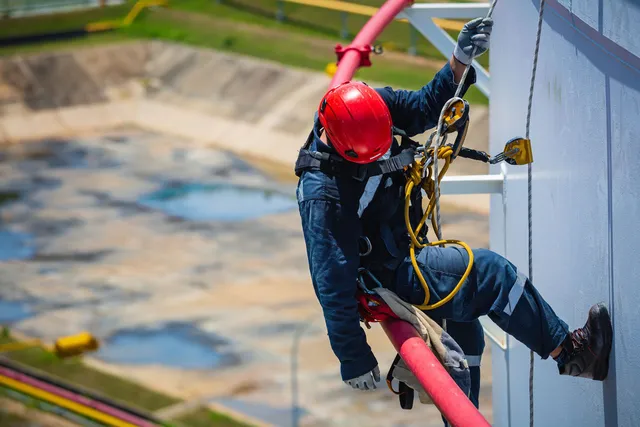In the world of building maintenance, high-rise buildings require specialised care to ensure their structural integrity and aesthetic value. One of the most effective methods that remedial builders use for maintenance tasks in these tall structures is rope access. This technique allows for quick, cost-effective, and safe access to hard-to-reach areas, such as building facades, windows, and rooftops.
As buildings grow taller and cities become more densely populated, the need for advanced maintenance techniques like rope access continues to increase. This article explores how remedial builders use rope access for building maintenance, the benefits of this method, and why it has become the preferred solution for many high-rise building owners.
What Is Rope Access in Building Maintenance?
Rope access, in the context of building maintenance, refers to a method where remedial builders use ropes, harnesses, and other climbing gear to access high or difficult-to-reach areas of a building. This technique allows workers to move freely around a building’s exterior, performing tasks such as inspections, repairs, cleaning, and painting.
Rope access is a highly efficient method for accessing all parts of a building without the need for scaffolding or cranes, making it ideal for buildings in areas with limited space or high pedestrian traffic. It is also more cost-effective and quicker than traditional methods, and in many cases, it provides more flexibility when performing maintenance tasks.
The Role of Remedial Builders in High-Rise Building Maintenance
Remedial builders are integral to maintaining the safety, functionality, and appearance of high-rise buildings. These professionals possess the expertise to conduct various maintenance tasks, ensuring that the building remains in optimal condition throughout its lifespan. Their services include:
- Structural Inspections and Assessments: Regular inspections are vital for identifying potential issues such as cracks, leaks, or other structural damages that could compromise the building’s integrity.
- Repairs and Restoration: Remedial builders perform essential repairs to building exteriors, including fixing cracks, leaks, or damage caused by weather conditions.
- Cleaning and Maintenance: Maintaining the cleanliness of the building’s exterior, windows, and facade is crucial not just for aesthetic purposes but also to prevent potential damage from dirt, algae, or other environmental factors.
- Safety Inspections: Ensuring that the building is safe for occupants, including inspecting rooftop equipment and ensuring that it adheres to safety regulations.
Rope access allows remedial builders to perform these tasks efficiently without the need for heavy machinery, making the work less disruptive to the building’s inhabitants and surrounding areas.
Benefits of Rope Access for High-Rise Building Maintenance
Cost-Efficiency in High-Rise Maintenance
Rope access is highly cost-effective compared to other methods like scaffolding, which requires significant setup, installation, and maintenance costs. Since it doesn’t require bulky equipment or lengthy setup times, it allows remedial builders to offer lower prices for building maintenance services, particularly for high-rise buildings that require frequent inspections and repairs. This cost-saving aspect is one of the primary reasons why many building owners choose rope access for exterior maintenance.
Minimal Disruption to Daily Operations
Traditional methods like scaffolding can block pathways and cause inconvenience to tenants, visitors, and pedestrians. Rope access, however, requires minimal space and doesn’t obstruct access points. For this reason, remedial builders can carry out repairs and maintenance without disrupting daily operations in the building. Tenants can continue with their day-to-day activities without being affected by the maintenance work being carried out.
Safety and Compliance with Industry Standards
The safety of workers is paramount when performing maintenance on high-rise buildings. Rope access adheres to strict safety standards that protect the workers, the building, and its occupants. All remedial builders involved in rope access are required to undergo extensive training and certification, ensuring that they have the skills needed to perform maintenance tasks safely. Additionally, since rope access does not involve scaffolding or cranes, it significantly reduces the risk of accidents related to heavy equipment.
Increased Flexibility in Accessing Building Areas
Rope access provides unparalleled flexibility when it comes to accessing hard-to-reach areas of a building. Remedial builders can reach windows, facades, rooftops, and other difficult-to-access places with ease. This makes rope access the ideal method for a wide range of maintenance tasks, including inspections, repairs, cleaning, and painting. The ability to work from any part of the building, without being constrained by equipment setup, makes rope access the most versatile solution for building maintenance.
Time-Saving Advantages for High-Rise Maintenance
Rope access allows remedial builders to begin working on high-rise building maintenance almost immediately, as it doesn’t require time-consuming setup like scaffolding or crane installation. Maintenance tasks can be completed faster, reducing the downtime of the building and allowing for quicker turnaround times. This time-saving advantage is especially beneficial for building owners who want to minimise disruption to their tenants.
Common Tasks for Remedial Builders Using Rope Access
Rope access is not only used for basic inspections but also for a wide range of essential building maintenance tasks. Some of the most common tasks that remedial builders use rope access for include:
1. Window Cleaning and Restoration
Windows in high-rise buildings are exposed to the elements, which can cause them to accumulate dirt, algae, and pollutants. Rope access allows remedial builders to clean and restore these windows safely and efficiently. This task not only improves the building’s appearance but also helps maintain the structural integrity of the windows by removing contaminants that could cause damage over time.
2. Façade Inspections and Repairs
The façade of a building is constantly exposed to weather conditions such as rain, wind, and pollution, which can cause wear and tear. Using rope access, remedial builders can inspect the façade for signs of damage such as cracks or leaks. If any issues are identified, the remedial builders can carry out the necessary building repairs, preventing further damage and ensuring the building remains structurally sound.
3. Roof Inspections and Maintenance
Rooftop areas are essential parts of any high-rise building. They house critical infrastructure like HVAC systems and water tanks, and they also protect the building from environmental elements. Rope access allows remedial builders to perform regular roof inspections and maintenance tasks, such as checking the condition of roofing materials, inspecting safety equipment, and ensuring that the drainage systems are functioning correctly.
4. Exterior Painting and Coating
To protect the building from weathering and environmental damage, remedial builders often apply protective coatings or paint to the building’s exterior. Using rope access, this task can be completed without the need for scaffolding, allowing for a smooth, efficient application process. This is especially important for maintaining the building’s aesthetic appeal and preventing long-term damage from environmental exposure.
5. Structural Repairs
Rope access is often used for carrying out minor structural repairs on high-rise buildings. This can include patching cracks, repairing leaks, and reinforcing weakened areas of the building’s exterior. By using rope access, remedial builders can reach these areas quickly, preventing further damage and ensuring that the building remains safe for its occupants.
Why Building Owners Prefer Rope Access for Maintenance
1. Increased Safety and Reduced Risks
One of the major benefits of rope access is the reduced risk of injury or accidents. Unlike scaffolding, which can create hazardous conditions for workers, rope access is a safer alternative because it minimises the risk of falling from heights or being struck by equipment. All workers involved in rope access are trained in safety protocols, including emergency rescue procedures, ensuring that both the workers and the building are safe throughout the maintenance process.
2. Long-Term Savings
Although the initial costs of rope access may be higher than traditional methods, the long-term savings make it a cost-effective choice. The ability to perform maintenance tasks without the need for scaffolding or cranes reduces the overall cost of repairs and inspections, making rope access a highly cost-effective solution for building maintenance.
3. Preservation of the Building’s Aesthetic Value
By using rope access for regular cleaning and repairs, remedial builders can preserve the building’s aesthetic value for years. This is especially important for high-rise buildings in urban areas where appearances are important for attracting tenants or customers. Maintaining a clean and well-kept exterior improves the building’s reputation and marketability.
4. Minimal Disruption to Tenants
Rope access allows remedial builders to perform maintenance tasks without disrupting the daily operations of the building. Since the method doesn’t require scaffolding or other bulky equipment, tenants and visitors can go about their day without being affected by the maintenance work. This non-disruptive approach is especially important in residential or office buildings where occupants rely on their normal routines.
Conclusion
Rope access has become an indispensable tool for remedial builders in building maintenance tasks, especially for high-rise buildings. Its cost-effectiveness, minimal disruption, and ability to access hard-to-reach areas make it the preferred method for building owners and facility managers. By opting for rope access, you ensure regular maintenance without the hassle of scaffolding, allowing remedial builders to perform essential repairs, cleaning, and inspections safely and efficiently. Whether for residential or commercial buildings, rope access continues to be a vital solution for preserving the integrity and appearance of high-rise structures, offering long-term value and peace of mind.
FAQS About Rope Access in High-Rise Building Maintenance
What exactly is rope access, and how is it used for building maintenance?
Rope access is a technique where remedial builders use ropes and harnesses to access hard-to-reach areas of a building for maintenance tasks. This method is ideal for building maintenance tasks such as window cleaning, façade repairs, and roof inspections.
How safe is rope access for remedial builders working at great heights?
Rope access is governed by strict safety standards, and all remedial builders are trained and certified to perform maintenance tasks safely. Regular inspections and safety protocols are in place to ensure that the work is carried out without risk to the workers or the building.
Can rope access be used for both residential and commercial buildings?
Yes, rope access is suitable for both residential and commercial buildings. Whether it’s a high-rise apartment complex or a commercial office tower, remedial builders can use rope access to perform a wide range of building maintenance tasks.
How often should high-rise buildings undergo maintenance using rope access?
It is recommended that high-rise buildings undergo maintenance every 6 to 12 months, depending on factors like location, exposure to the elements, and the age of the building. Regular inspections can help detect potential issues before they become major problems.
What are the main benefits of using rope access for building maintenance?
Rope access offers several benefits, including cost savings, minimal disruption to daily activities, enhanced safety, and the ability to access hard-to-reach areas quickly. This makes it an efficient and effective solution for high-rise building maintenance.











